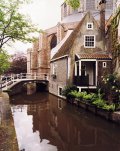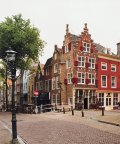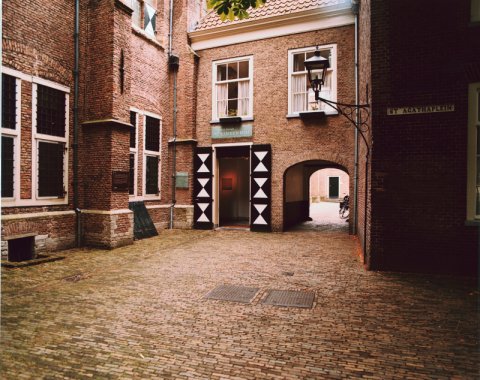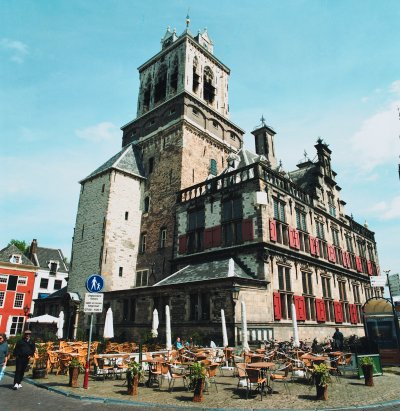
SYMPOSIUM AND EXHIBITION
| October 26-29, 2003 Delft, The Netherlands |
INFORMATION ABOUT DELFT
![]()

Center of Delft
(Vrouwenregt)

Center of Delft
(Camaretten)
General information Delft
Delft is one of the best preserved old Dutch cities. It is not far from The Hague (10 km), Rotterdam (15 km) and Amsterdam (60 km), which all can be reached from Delft by train (every 15 minutes). Delft is famous for its canals, historical buildings, and its New Church with the crypt of the Royal Family and the Mausoleum of Prince William I (the architect of the Dutch independence). At the Royal Delftware Factory "De Porceleyne Fles", one can visit the splendid permanent exhibition and attend hand painting demonstrations.
Historical Town
The old inner city of Delft, which was enfranchised in 1246, still bears the marks of its glorious history. The past comes to life as you stroll along the stately mansions, by quiet courts of almshouses and through the alleys interconnecting the canals. Its cozy character and monumental buildings in various styles have been carefully preserved. The Eastern Gate, the 'Gemeenlandshuis' and the 'Armamentarium' are fine examples of architectural masterpieces from the days of yore. The market square is dominated by the Town Hall and the impressive New Church, with in between them the statue of Hugo de Groot, better known as Grotius. Other famous natives of Delft, such as the painter Johannes Vermeer, are buried in the Old Church, where extraordinary stained-glass windows catch the eye. In eight museums old works of art and cultural treasures illustrate the national history as well as that of Delft.

The "Prinsenhof" (Court of Princes) in the center of Delft
Town of Princes
Delft has special ties with the Dutch Royal House, more so than any other city in the Netherlands. This connection dates from the turbulent times in which prince William of Orange (1533-1584), the 'Father of the Fatherland', thought himself safe behind the town ramparts of the Cloister of Saint Agatha. He and his court had frequently stayed here since 1572 and he was assassinated here in 1584. The bullet holes are still visible in the present Municipal Museum the 'Prinsenhof'. The prince's marble mausoleum (1614-1622) can be admired in the New Church, over the vaults of the Royal Family. In the church an exhibition has been organized on the Royal funerals. The collection of the Royal Dutch Army and Arms Museum in the old armory the 'Armamentarium' shows, among other things, the genesis of the Kingdom of the Netherlands and the significant parts that have been played by the House of Orange as well as Delft.
Town of Delftware Delft is renowned all over the world as the city of Delft blue earthenware. This is also based on an age-old history. In the 17th century, the 'Golden Age', dozens of small potteries came into existence in Delft at places which formerly accommodated breweries. Delft was one of the home ports of the VOC, the Dutch East Indian company. When the Delft potters became acquainted with the imported Chinese porcelain, they began manufacturing earthenware with designs based on these patterns. Dutch porcelain, for that matter, is also decorated in beautiful multi-colored shades. In several workshops, including that of 'De Porceleyne Fles', the only surviving 17th century factory, Delftware is manufactured and hand-painted according to traditional methods. You're welcome to attend the demonstrations which are held regularly. In Museum Lambert van Meerten you will find a unique collection of tiles, tile pictures, porcelain and earthenware in original period rooms.
Delft, the university town, is famous for the lively atmosphere in its historic centre. Countless numbers of visitors enjoy its charming little shops, galleries, pubs, grand cafes, (gourmet) restaurants and cozy outdoor cafes on the market square and along the canals. During the summer there are various festivals, the barrel organ plays and terrace boats in the canals offer refreshments. The canals may also be explored by way of round-trip boats, pedal boats or canoes. An original horse-drawn tram will take you around the old city centre. For guided walking tours of the city you can call the Tourist Information Office. And then we have the markets: the big commodities market on the "Markt" and colorful flower markets as well as the popular flea market with its antiques and curiosa along the canals. This is something you shouldn't miss, if only for the cheerful ambience.

The Town Hall at the central market place in Delft
The host-city of
ESS 2003, Delft is not just a home of
history, painting and
culture but also a lively university town focused on science and high-tech.
Page created by Alexander Verbraeck. Last update 08-10-03.
© Copyright SCS European Council and SCS
International - All Rights Reserved
